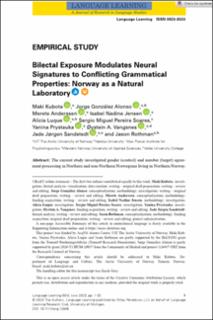Bilectal Exposure Modulates Neural Signatures to Conflicting Grammatical Properties: Norway as a Natural Laboratory
Kubota, Maki; Gonzalez Alonso, Jorge; Jensen, Isabel Nadine; Luque, Alicia; Pereira Soares, Sergio Miguel; Prystauka, Yanina; Vangsnes, Øystein Alexander; Anderssen, Merete Brendeford; Sandstedt, Jade Jørgen Michael; Rothman, Jason
Peer reviewed, Journal article
Published version
Permanent lenke
https://hdl.handle.net/11250/3108574Utgivelsesdato
2023Metadata
Vis full innførselSamlinger
Originalversjon
10.1111/lang.12608Sammendrag
The current study investigated gender (control) and number (target) agreement processing in Northern and non-Northern Norwegians living in Northern Norway. Participants varied in exposure to Northern Norwegian (NN) dialect(s), where number marking differs from most other Norwegian dialects. In a comprehension task involving reading NN dialect writing, P600 effects for number agreement were significantly affected by NN exposure. The more exposure the NN nonnatives had, the larger the P600 was, driven by the presence of number agreement (ungrammatical in NN). In contrast, less exposure correlated to the inverse: P600 driven by the absence of number agreement (ungrammatical in most other dialects). The NN natives showed P600 driven by the presence of number agreement regardless of exposure. These findings suggests that bilectalism entails the representation of distinct mental grammars for each dialect. However, like all instances of bilingualism, bilectalism exists on a continuum whereby linguistic processing is modulated by linguistic experience.
